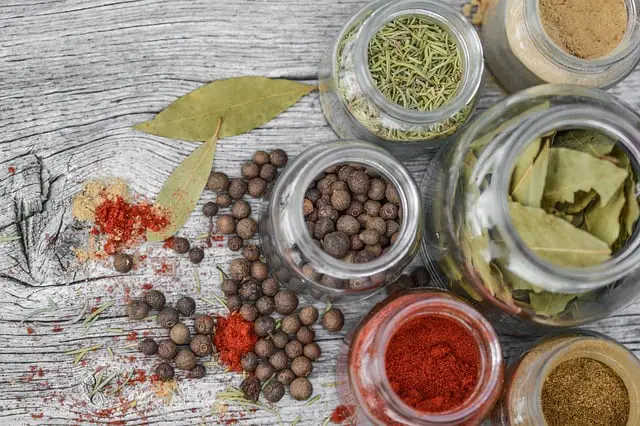Spices and herbs are often used interchangeably, but they are different in terms of their taste, usage, and origin. Herbs come from the green and leafy parts of the plant in question whereas the spice tends to come from the root, stem or seed of the plant.
While they are often used together in dishes, it’s worth knowing the differences and how to use each to make your food dishes as tasty as they can be.
Herbs vs spices
Here is the difference between spices and herbs:
- Origin: Spices are obtained from the bark, roots, seeds, or fruit of plants, while herbs are obtained from the leaves and green parts of plants.
- Flavor and aroma: Spices tend to have a stronger, more intense flavor and aroma than herbs. Herbs are often used to add a milder, subtler flavor to dishes.
- Usage: Spices are used in cooking and baking to enhance the flavor of food, while herbs are used to flavor soups, sauces, and stews, and to garnish dishes.
- Culinary tradition: Spices are often associated with cuisines from around the world, while herbs are often associated with European and Mediterranean cuisines.
10 Popular Herbs
- Basil
- Rosemary
- Thyme
- Sage
- Oregano
- Parsley
- Chives
- Tarragon
- Mint
- Dill
10 Popular Spices
- Black Pepper
- Ginger
- Cinnamon
- Turmeric
- Cumin
- Coriander
- Cloves
- Cardamom
- Mustard Seeds
- Star Anise
These are just a few of the many popular herbs and spices used in cooking and baking around the world. Each of these ingredients offers a unique flavor and aroma that can be used to enhance the taste of a wide variety of dishes.
Whether you prefer sweet, spicy, or savory flavors, there is sure to be a herb or spice that will suit your taste.
Using spices and herbs in conjunction with one another
There are many combinations of spices and herbs that are used together in a dish to create complex and delicious flavors.
Here are a few popular combinations:
- Rosemary and garlic: These two herbs are often used together in meat dishes, such as roasted chicken or grilled steak which can also use spices such as paprika, garlic and cumin.
- Oregano and basil: These herbs are commonly used together in tomato-based sauces, such as marinara or pizza sauce alongside garlic, pepper and cumin.
- Thyme and bay leaves: These herbs are often used together in stews and soups to add depth of flavor which can also use spices such as garlic, cinnamon or ginger depending on the dish.
- Cumin, coriander, and chili powder: These spices are often used together in Mexican and Southwestern cuisine, particularly in dishes like chili, tacos, and enchiladas alongside oregano, cilantro and thyme.
- Cinnamon, nutmeg, and allspice: These spices are commonly used together in sweet dishes, such as pie, cake, and pumpkin bread. Herbs used in sweets include mint, vanilla and lavender.
- Ginger, cardamom, and cloves: These spices are often used together in Indian and Middle Eastern cuisine, particularly in dishes like curry, chai tea, and biryani alongside herbs like sage and mint.
In conclusion, the use of spices and herbs together in a dish can add layers of flavor and aroma that make a dish truly special. Experimenting with different combinations is a great idea so that you find the ones that work best for your personal taste.
Spices and herbs come in different forms
You can choose herbs and spices in various forms. Here’s how they are generally used and why you might choose one form over another.
Herbs are generally used in one of two forms: fresh or dried
- Fresh herbs: Fresh herbs are typically used in their whole leaf form and are added to dishes for flavor and aroma. They are best used in raw dishes or added at the end of cooking to preserve their delicate flavor.
- Dried herbs: Dried herbs are used in ground form and are added to dishes for flavor and aroma. Dried herbs are more potent than fresh herbs, so less is needed to achieve the same flavor. They are best used in dishes that cook for a longer time, as the extended cooking time allows the flavors to meld together.
Spices are generally used in one of three forms: whole, ground, or fresh
- Whole spices: Whole spices are used in their whole form and are added to dishes for flavor and aroma. They are often used in dishes that cook for a long time, as the extended cooking time allows the flavors to meld together. Whole spices can also be toasted to bring out their flavor.
- Ground spices: Ground spices are used in a powdered form and are added to dishes for flavor and aroma. They are more potent than whole spices, so less is needed to achieve the same flavor. Ground spices are best used in dishes that cook for a shorter time, as their potency can quickly dissipate with extended cooking.
- Fresh spices: Fresh spices are used in their whole form and are added to dishes for flavor and aroma. They are often used in raw dishes or added at the end of cooking to preserve their delicate flavor. Fresh spices have a milder flavor than dried spices and are not as commonly used in cooking.
Summary
In conclusion, while spices and herbs share some similarities, they are distinct ingredients that offer unique flavors, aromas, and uses in cooking and baking. Understanding the difference between the two can help you to make the most of these ingredients in your kitchen.

